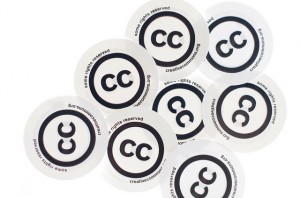Keeping it legal: Images licensed through Creative Commons
Let’s say you’ve got a blog or a news website and you want a free image for your article or post. You could just go to Google Images and copy the first one you see but you could well be infringing on someone’s copyright. This isn’t just unfair to the photographer or graphic designer, it could also end up being expensive for you if they demand damages. A legal alternative is to look for images with a Creative Commons (CC) license, which allows you to use the pictures under certain conditions. onMedia’s Kyle James, who’s a CC fan, goes into the details.
Those of you who have read my onMedia posts before may have noticed many of my images are credited with a formula that looks like this: “Photo: flickr/(a screen name).” What that means is I’ve found the images on flickr, a photo and video-hosting site. But I can’t just copy any image from flickr – just those with Creative Commons licenses, meaning the creator of the image has said it’s fine if others use it, as long as they follow a few stipulations.
Using CC-licensed images means you don’t have to worry about breaking copyright law and risk the chance that some angry photographer takes you to court.
And, best of all, they are free! After all, not everyone has the budget to buy images from Shutterstock or Getty Images, or has access to the AP photo database. So CC is a great alternative.
A little history
Creative Commons is a non-profit group founded in 2001. It aims to be something of a halfway house between full copyright, the default “all rights reserved” version and an intellectual property free-for-all, where anyone can use anything created by anyone at any time. So, CC has a “some rights reserved” model, the details of which we’ll go into a little later.
The CC folk believe the more people can access creative works, the better. And that sharing is better than holding onto things too tightly. (Read more about their philosophy here.)CC licenses are not limited to photographs. Books, plays, movies, music, articles, blogs, websites and even databases can be licensed under the CC system. But for this post, we’re focusing on images.
The common licenses
When someone creates a work—snaps a photograph or doodles a cartoon character—they can go to the Creative Commons website and decide which license they want to apply to their image. There are several main restrictions they can decide on; they have a two-letter acronym and icons. The most common ones are as follows:
- (BY) Attribution – All the licenses require you to credit the original author in the way they want to be credited. It’s not always their name, as I found out in the occasionally interesting handles (names) people use on flickr.
- (NC) Non-commercial – People can use the work but they can’t use it to make money. If a profit is going to be made off it, you will need to talk to the creator of the work.
- (ND) No derivatives – The work has to be used in its original form. That means you can’t alter or photoshop the image in any way.
- (SA) Share alike – The image can’t be placed under any different or more restrictive terms for re-use than those set by the original creator of the image.
The above license terms can be combined in various ways, creating different types of licenses. The six regularly used ones are:
- BY – Redistribution is allowed if the creator of the image is credited.
- BY-ND – This allows for redistribution, even for profit, as long as the creator is credited and the image is used in its unchanged, original form.
- BY-NC – The image can be used for non-commercial purposes only and the creator must be credited.
- BY-SA – Attribution is necessary in this case and no different restrictions can be put in place than set by the creator of the image.
- BY-NC-ND – Money cannot be made off of the image, the photographer must be credited and the original form of the image cannot be changed.
- BY-NC-SA – Credit must be given where credit is due, profit is out of the question, and the license of derivatives must remain the same as the one put on the original work.
Whew! There’s some alphabet soup but it’s important to know so you can be sure you acting in line with the wishes of the image creator.
How to attribute
You’ll notice that all of the license types include attribution. What that attribution should look like is a matter up for debate; there is no set standard. However, there are some things you should take into consideration when attributing to make sure that the image creators are getting the credit they deserve. In the past, I’ve used the formula: Photo: flickr/(creator’s flickr handle). Then I made the credit an active link that goes to the page of flickr where I found the work.
But, some don’t think this is quite enough. I tend to agree with them so as you can see in this post, I’ve now changed to the following option: I have included the Creative Commons the work is licensed under, such as CC BY-NC-4.0. (4.0 refers to the latest license version). If you want, you can even link to the license description on the CC website. Others prefer including the photo’s title, for example, my picture to the left could be captioned:
“Woman in Rickshaw” by Kyle James is licensed under CC BY-NC-4.0.
I think that’s a little long but it’s definitely thorough!
Wikimedia even offers suggested attribution text.
It’s also nice to send a message to the creator (which you can easily do on flickr), telling the image author you’ve used the photo and maybe a link to it. It makes everyone feel good.
What is NOT correct is something like this: Photo: Creative Commons. Why? Well, the author’s name is not mentioned, there’s no link to the original photo, no title and there’s no mention of the license. Creative Commons is the organization, not the license. They’ve got a more exhaustive list of attribution best practices here.
Finding CC images
So now you’ve got the basics of CC. Now, how do you find your images? Creative Commons has a search page that puts you in touch with a treasure trove of usable media. You enter a search term and then you can choose a variety of places to look, from flickr to Google Images to WikiMedia Commons to other sources. It also gives you options for searching for other CC-licensed media, such as video or music.
You can search, of course, directly at flickr, and they’ve changed their interface to make looking for CC images easier. After you’ve entered the search term, on the results page a few drop-down menus appear, including one called “License.” Just make sure you choose Creative Commons. Compfight, which is a gateway to flickr images, is useful. There are some handy search options easy to access and it appears to load faster and display more photos per page than its source site. So, you don’t have to scroll through page after page of flickr pics. Others options include Photopin, flickrstorm or Free Images (it’s not a CC site, per se, but has uploaded pictures that are often royalty free. But you have to check on each picture to see what the usage rights are.) Try out a few and see which one has the features you like.
Author: Kyle James





![Image: John Randell [public domain], via Wikimedia Commons](files/Creative-Common-logo-John-Randell-300x113.jpg)

